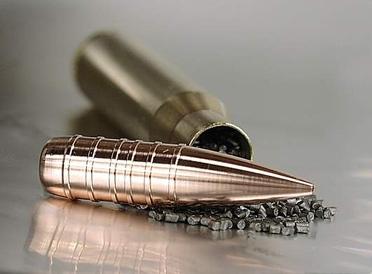

 The Accurate Reloading Forums
The Accurate Reloading Forums  THE ACCURATE RELOADING.COM FORUMS
THE ACCURATE RELOADING.COM FORUMS  Guns, Politics, Gunsmithing & Reloading
Guns, Politics, Gunsmithing & Reloading  Bullet Making
Bullet Making  length of ogive calculation:
length of ogive calculation:Go  | New  | Find  | Notify  | Tools  | Reply  |  |
| one of us |
Alright! So, make a circle as many times bigger than your caliber as the radius power, (e.g., a 6S ogive for a .308" would take a circle diameter of 1.848") then subtract your caliber's width and the radius of the big circle from the big circle's diameter. Square the sum and subtract that from the square of the big circle's radius. That sum's square root is the axial length of the ogive. c= caliber o= ogive power l=nose length (co/2)^2-((co-c-(co/2))^2)=l^2 That's for a perfect point. Try it! Now, Who knows how to get the length when there's a meplat? My brain hurts! Taylor | ||
|
| One of Us |
The short answer is that you use the equation for a circle (x-h)*(x-h) + (y-k)*(y-k) = r*r, where (h,k) is the center of the circle. Personally, I am always puzzled when people insist on a certain ogive radius. This must be a carryover from military-think, where the radius of a spitzer nose influences the BC. On a flat nose bullet, it's more practical to worry about things like how much nose you want sticking out of the bullet and how big the meplat is. | |||
|
| one of us |
I'm not talking flatnose. It's just that the internal punch is .12", and so if I use that I get my nose length, can guess at BC, and find out if it will match my chambercast. A meplat this size (33% in a 358) is enough to change the bullet length, but still close enough to a point to make a real change in BC between a 6S and 8S. Plus, I get bored sometimes. I'll try your equation. What I got was: x= sqrt(c^2 - 4y sqrt(4r^2 - c^2))/2 where x is the length of the ogive, c is twice the length of the ogive with true point (chord length), and y is half the meplat. Cum catapultae proscriptae erunt tum soli proscript catapultas habebunt. | |||
|
| Powered by Social Strata |
| Please Wait. Your request is being processed... |
|

Visit our on-line store for AR Memorabilia

